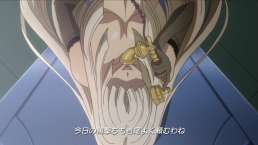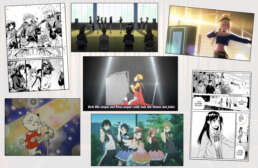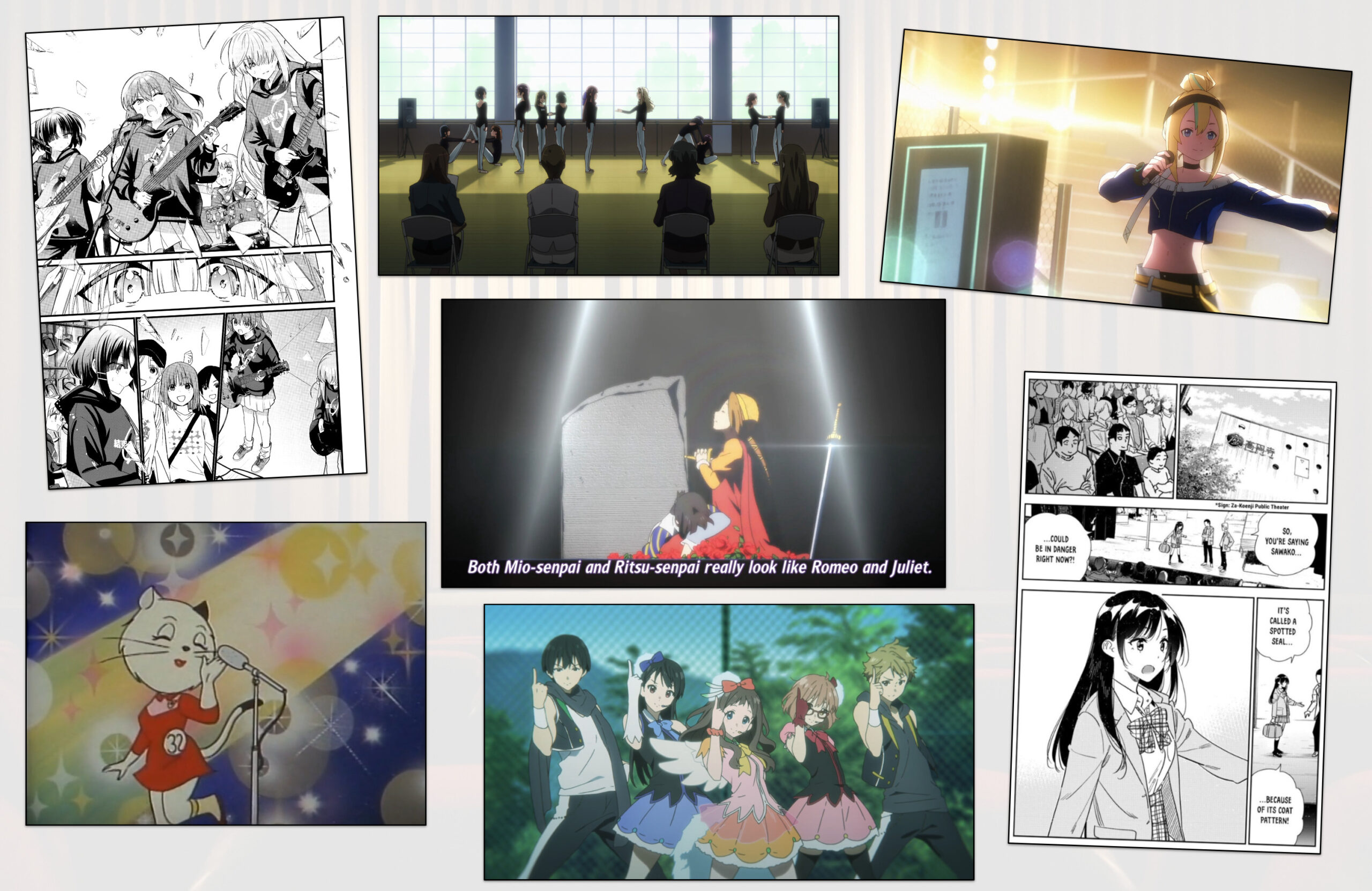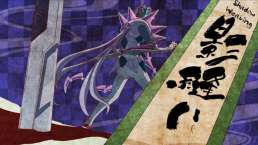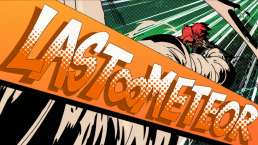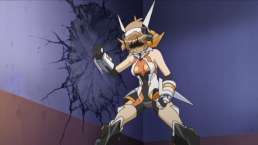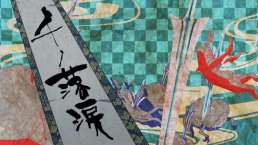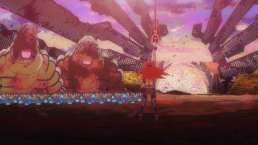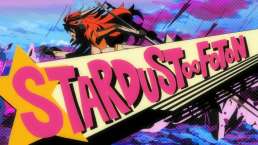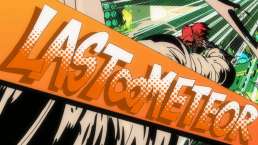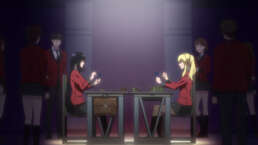Symphogear Episode 05: From the Bottom of Darker Depths
Episode Summary:
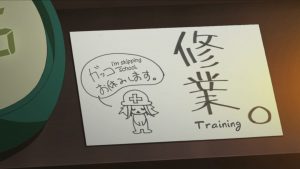 This episode starts with Hibiki leaving Miku behind in order to train. Hibiki seems like she is getting good, given the way she hits that punching bag!
This episode starts with Hibiki leaving Miku behind in order to train. Hibiki seems like she is getting good, given the way she hits that punching bag!
After the opening, we get this long scene with another new villain character. This woman seems to be in charge of the mystery girl who attacked Tsubasa. We learn that mystery girl’s name is Chris and she is being commanded, sexually abused, and tortured by this new villainess. Chris seems to be under the impression that all of it is necessary to fulfill some sort of wish she has.
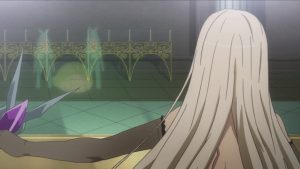 This new villainess seems to be in contact with someone who speaks English. They provided her with Soloman’s Cane (the relic that summons Noise?) and now she is lying to them about not being able to activate it.
This new villainess seems to be in contact with someone who speaks English. They provided her with Soloman’s Cane (the relic that summons Noise?) and now she is lying to them about not being able to activate it.
Hibiki is still taking the day off to train. At 2nd division headquarters, she learns about the uncomfortable situation the “Disaster Squad” is in politically, and that the Japanese government is funding the Symphogear project as a hedge against other nations. But there is one good minister who looks out for 2nd Division.
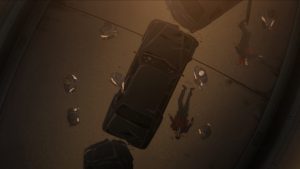 The exact order of the next series of events is a little unclear. Ryoko is summoned to report to the minister. At some point, she returns with new orders… but in the meantime that minister is ambushed and killed by the person who was talking to the villainess over the phone. If things were just in that order, it would be tragic but not suspicious. But instead, the series of events is suspicious because Ryoko returns with what seems to be the carrying case the minister was protecting and the case has blood on its bottom edge.
The exact order of the next series of events is a little unclear. Ryoko is summoned to report to the minister. At some point, she returns with new orders… but in the meantime that minister is ambushed and killed by the person who was talking to the villainess over the phone. If things were just in that order, it would be tragic but not suspicious. But instead, the series of events is suspicious because Ryoko returns with what seems to be the carrying case the minister was protecting and the case has blood on its bottom edge.
While all this is happening, Tsubasa is still in her coma and is dreaming about Kanade. She remembers their bad times and their good times, but just before she wakes up she realizes that she can hold Kanade’s memory as close as she wishes to. Tsubasa wakes up for the first time since the battle and seems to resolve to be more flexible from now on.
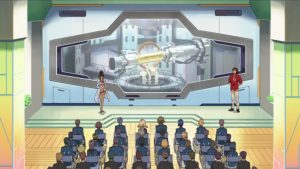 Back at 2nd division, Ryoko claims to be unaware of the minister’s assassination, and proceeds to inform everyone of new orders to transfer a powerful relic named Durandal from beneath headquarters to a separate vault beneath parliament.
Back at 2nd division, Ryoko claims to be unaware of the minister’s assassination, and proceeds to inform everyone of new orders to transfer a powerful relic named Durandal from beneath headquarters to a separate vault beneath parliament.
Hibiki and Miku are still deflecting off each other, but Ogawa helps cheer Hibiki up by reminding her that even the little things are being taken care of by a team of people.
The next morning comes, and Hibiki and Ryoko set off with Durandal intending to escort it to its new destination. Things don’t go as planned when Noise attack the convoy of cars leading to a big fight at a chemical plant where Ryoko blocks a Noise attack with an unexpected forcefield.
 Hibiki is a much better fighter now after Genjuro’s training. She takes on a whole crowd of noise by herself by using a series of kicks, punches, and dodges. Chris attacks and gets a good hit on Hibiki, but then Durandal, which is apparently a sword, breaks free of its case and Hibiki manages to grab it. Hibiki’s rage returns, and in one swing of Durandal she destroys the chemical plant before fainting.
Hibiki is a much better fighter now after Genjuro’s training. She takes on a whole crowd of noise by herself by using a series of kicks, punches, and dodges. Chris attacks and gets a good hit on Hibiki, but then Durandal, which is apparently a sword, breaks free of its case and Hibiki manages to grab it. Hibiki’s rage returns, and in one swing of Durandal she destroys the chemical plant before fainting.
In the end, Ryoko suggest Hibiki not worry about the forcefield she saw then walks off to help with the cleanup.
Episode Impressions:
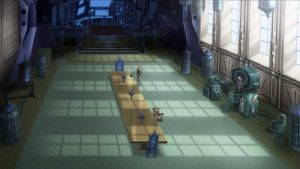 This is an interesting episode. We seem to be introducing the main villain of the series, we get to see Hibiki fight after she concludes her training, and Tsubasa might now be on a better path than she was before.
This is an interesting episode. We seem to be introducing the main villain of the series, we get to see Hibiki fight after she concludes her training, and Tsubasa might now be on a better path than she was before.
This episode is also filled with mysteries and no small amount of suspicion. Who was the villainess talking to? Why does she have control of Chris? What does Chris want? And why did Ryoko return with blood on that carrying case?
And yeah, overall, this episode was good. It moved several things forward and asked all those interesting questions. Maybe it was a little confusing, but I think it is holding things back on purpose to create that suspicion about Ryoko.
Specific Scenes I Loved:
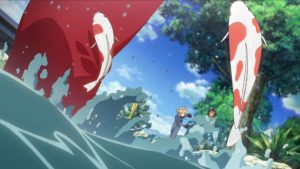 Hibiki knocking the punching bag into the pond after acting on Genjuro’s silly nonsense advice.
Hibiki knocking the punching bag into the pond after acting on Genjuro’s silly nonsense advice.
Tsubasa’s dream sequence. I think she finally realized something important before waking up. Plus, it was nice seeing Kanade again.
Ogawa reminding Hibiki that there is a team supporting her.
Hibiki’s first real fight against the Noise. Some of those moves and animations are real quick but really, really good. Especially when she dodges all those tentacles. There’s a cartwheel in there as well as a frame or two where she punches one of the tentacles aside!
Songs In This Episode:
Gekisou Gungnir – No new songs yet, but it’s nice to see Hibiki fighting along with her song. I liked the part about “I’ve found it, the place where my heart belongs” as she was taking on the Noise. That was good.
Themes In This Episode:
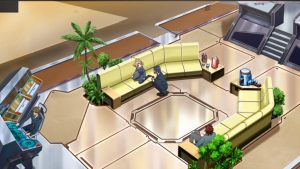 One theme that gets touched on a couple times this episode is that there are teams of people helping make even the small things possible. We see it first when Hibiki worries about her actions as a Symphogear user and she’s told not to worry because 2nd Divison’s staff helps keep things secret. The minister helping 2nd division could be considered another layer of this, helping keep them clear of government politics. Later, Ogawa reminds Hibiki that he and many others are there to help both her and Tsubasa live their lives and do their jobs as Symphogear users. It’s not said directly, but one way to look at it is even superheroes need help.
One theme that gets touched on a couple times this episode is that there are teams of people helping make even the small things possible. We see it first when Hibiki worries about her actions as a Symphogear user and she’s told not to worry because 2nd Divison’s staff helps keep things secret. The minister helping 2nd division could be considered another layer of this, helping keep them clear of government politics. Later, Ogawa reminds Hibiki that he and many others are there to help both her and Tsubasa live their lives and do their jobs as Symphogear users. It’s not said directly, but one way to look at it is even superheroes need help.
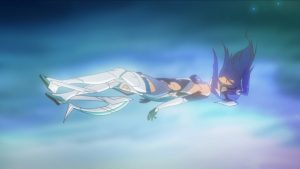 Tsubasa’s dream sequence with Kanade. I don’t think the two are literally talking to each other. As in, it’s not Tsubasa being encouraged by Kanade’s spirit or ghost. Rather, I think Tsubasa is working out for herself the path she needs to take to move forward. And her subconscious is using her memories of Kanade, both good and bad, to help with that process. There’s some good stuff here. Most notably, we come back to the theme of being flexible. Tsubasa nearly died because she wasn’t willing to let anyone in to her life after Kanade’s death. Really, she nearly killed herself. Her comment about failing to die shows us she did not intend to survive defeating Chris. When she came upon an enemy she couldn’t take on alone, she didn’t have a partner to help her. Imagine if instead of ignoring and hating Hibiki, Tsubasa had welcomed her as a Symphogear user and had helped teach her how to fight. The battle against Chris in the previous episode might have gone very differently!
Tsubasa’s dream sequence with Kanade. I don’t think the two are literally talking to each other. As in, it’s not Tsubasa being encouraged by Kanade’s spirit or ghost. Rather, I think Tsubasa is working out for herself the path she needs to take to move forward. And her subconscious is using her memories of Kanade, both good and bad, to help with that process. There’s some good stuff here. Most notably, we come back to the theme of being flexible. Tsubasa nearly died because she wasn’t willing to let anyone in to her life after Kanade’s death. Really, she nearly killed herself. Her comment about failing to die shows us she did not intend to survive defeating Chris. When she came upon an enemy she couldn’t take on alone, she didn’t have a partner to help her. Imagine if instead of ignoring and hating Hibiki, Tsubasa had welcomed her as a Symphogear user and had helped teach her how to fight. The battle against Chris in the previous episode might have gone very differently!
Tsubasa still has Kanade with her. We also get this little thing where Tsubasa realizes that she has been keeping Kanade’s memories distant. She considered Kanade dead and gone, but now I think she has realized that it doesn’t have to be that way. Instead, she can cherish her time with Kanade and hold her lessons close instead of locking all those memories far away.
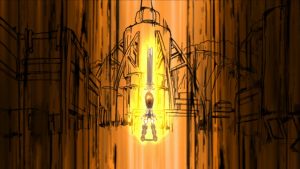 We’ve also come back to Hibiki’s rage. She can hardly control herself after she grabs Durandal. And then she sends an attack at Chris without a moment’s hesitation. Remember, in the previous episode, Hibiki grabbed onto Tsubasa to prevent her from attacking Chris, because Chris was a fellow human. That didn’t seem to be a problem for Hibiki in this episode, but then, she wasn’t thinking clearly at the moment she swung Durandal at Chris…
We’ve also come back to Hibiki’s rage. She can hardly control herself after she grabs Durandal. And then she sends an attack at Chris without a moment’s hesitation. Remember, in the previous episode, Hibiki grabbed onto Tsubasa to prevent her from attacking Chris, because Chris was a fellow human. That didn’t seem to be a problem for Hibiki in this episode, but then, she wasn’t thinking clearly at the moment she swung Durandal at Chris…
Special Attacks In This Episode:
Interestingly, there were no named special attacks this episode. I’d say Hibiki blowing up an entire facility in one swing of Durandal was pretty special… but it didn’t get a title card.
Things You Should Pay Attention To:
Ryoko performed multiple suspicious actions during the course of this episode. She returned with the blood on the carrying case. The orders she brought back said to move Durandal from a safe place to a less safe one, which seems very odd. When the Noise attacked, she suggested that she and Hibiki abandon Durandal. And then, of course, she had some sort of science or magic-based forcefield that she later told Hibiki not to worry about.
There’s one other thing… well, two maybe. The villainess controlling Chris and 2nd Division’s chief scientists, Ryoko, both like butterflies. The villainess is wearing a butterfly choker, while Ryoko has always had her butterfly hairpiece. The second thing? They have the same hair! Not the same hair color… but when Ryoko’s hair gets blown out of its bun, and especially when Chris looks questioningly back at Ryoko, Ryoko’s bangs and the two thin lose sections of her hair on the far left and right appear very similar to the villainess’s hair when she’s talking on the phone. Is it possible that Ryoko and the villainess are related somehow? Here’s three pictures demonstrating what I mean:
Moment By Moment Notes:
0:13 – Hibiki is still training
0:56 – There’s our mystery girl!
1:31 – There’s our mystery girl again!
1:42 – And there she is again in her stolen armor! So, she’s been a part of the show the whole time, and just hadn’t been introduced yet…
2:31 – So, someone handed a relic over in order for it to be activated? Solomon’s Cane?
2:41 – On the right held to a device is our mystery girl. She is clearly not the one in charge. This new woman is calling the shots, it seems.
3:28 – Is Solomon’s Cane the relic that summons Noise? It’s not the armor, right?
3:33 – Chris.
4:39 – Chris’s smile! She is being assaulted and tortured, but does she know any better? Why smile?!
4:55 – Miku is the best.
5:25 – Why rely on high school girls to fight? The classic magical girl question.
5:50 – So second division steps on a lot of toes to keep Symphogear research a secret
7:04 – Everyone has a job to do
7:46 – “No. I just failed to die.” That’s pretty grim!
8:00 – Too seriously, a reed before the wind.
8:21 – Tsubasa thought her life had no meaning or value…
8:33 – New philosophy from Kanade: There’s something beyond the fighting.
9:02 – It’s up to you to decide whether I’m close to you or not
9:10 – Tsubasa realizes she has a choice in how she remembers Kanade?
9:59 – So… has Tsubasa decided to be more flexible? To live with her failure? Or what?
10:26 – So this minister really is a good man who has the Disaster Squad’s back
11:04 – Or he was…
11:36 – Her phone was broken??
11:51 – WHY IS THERE BLOOD ON THE CARRYING CASE?!
12:05 – So the reason the Noise keep appearing is that they’re after the sword Durandal?? (Can we trust anything Ryoko is saying??)
12:14 – Darker Depths? The Abyss? That could be a callout to the episode title.
13:28 – Miku is getting tired of covering for Hibiki
13:53 – So the official story is that Tsubasa was hospitalized because of exhaustion
14:38 – Even the smallest things are backed by the efforts of many people
15:29 – Ryoko’s pink car is hilarious
16:54 – There is a chant of “Symphogear” in the background music
17:15 – Ryoko suggests just leaving the relic behind
17:28 – I think it’s important that Genjuro can’t see what happens next
17:31 – Ryoko can make forcefields?! Well… maybe it’s part of her science?
18:49 – First punch after training. Wow.
19:31 – Some really cool dodging animation followed up by this great punch
20:05 – Uh oh.
20:24 – That line art looks really cool
20:31 – And Hibiki is back in her rage mode
20:36 – Chris’s look back… To Ryoko…
20:40 – Ryoko is thrilled and fascinated with what’s going on
21:49 – Does it really matter (what happened)? Yes. I think it might! Ryoko is acting actually suspicious!
AniManga Picture Challenge Week 4 - Tops Stars of the Stage
Week 4 of the #AniMangaPictureChallenge opened the curtain on a wide variety of Top Stars of the Stage in #Anime and #Manga. Thanks to everyone who participated this week!
My Little Ponfarr - K-On!!
LiteralGrill - Sue Cat
Ragashingo - Revue Starlight
chikorita157 - Jellyfish Can't Swim in the Night
Retro Goth Bunny - Bocchi The Rock
Kafkaz - Rent-a-Girlfriend
Anicast - Beyond the Boundry
Starting tomorrow, we've got two back to back community topics. Want to suggest a topic? Just @ this account.
Symphogear Episode 04: Falling Tears
Episode Summary:
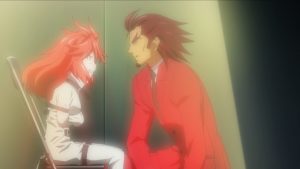 We start this episode five years before Tsubasa and Hibiki stare down the mystery girl wearing the Nehushtan armor. 2nd Division has just rescued Kanade Amou from the aftermath of a Noise attack on an artifact dig site. This isn’t the same calm, collected Kanade we first met three years later at the Zwei Wing concert in episode 1. As judged by the straight jacket she is strapped into, this Kanade is enraged to the point that she might even be a danger to herself and others. Through angered shouts and expletives, she makes clear that the only thing she wants is a way to kill the Noise who killed her family. No matter the personal cost to herself. All while a young Tsubasa watches timidly tucked away in her uncle’s shadow.
We start this episode five years before Tsubasa and Hibiki stare down the mystery girl wearing the Nehushtan armor. 2nd Division has just rescued Kanade Amou from the aftermath of a Noise attack on an artifact dig site. This isn’t the same calm, collected Kanade we first met three years later at the Zwei Wing concert in episode 1. As judged by the straight jacket she is strapped into, this Kanade is enraged to the point that she might even be a danger to herself and others. Through angered shouts and expletives, she makes clear that the only thing she wants is a way to kill the Noise who killed her family. No matter the personal cost to herself. All while a young Tsubasa watches timidly tucked away in her uncle’s shadow.
Genjuro and Ryoko put Kanade through a series of experiments meant to see if she can link with a Relic. While Tsubasa can naturally link with her Ame no Habakiri, it at first it seems like Kanade is unable to do the same. It’s only after Kanade takes matters into her own hands and injects herself with a dangerous overdose of the drugs they were testing on her that she is able to form a bond with Gungnir. In a dramatic scene she coughs up quite a bit of blood but successfully summons her Symphogear in the end.
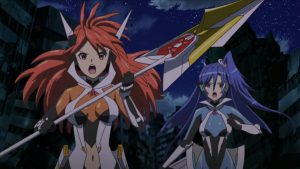 From then on, Kanade fights for revenge along side Tsubasa. Until, after one battle, some soldiers the two saved note how nice it was to hear Kanade’s singing in the midst of battle. This has a transformative effect on Kanade. Her worldview that only contained thoughts of revenge shifts to one of using her abilities to make people happy which leads to the creation of Zwei Wing.
From then on, Kanade fights for revenge along side Tsubasa. Until, after one battle, some soldiers the two saved note how nice it was to hear Kanade’s singing in the midst of battle. This has a transformative effect on Kanade. Her worldview that only contained thoughts of revenge shifts to one of using her abilities to make people happy which leads to the creation of Zwei Wing.
Back in the present, Tsubasa stares down the mysterious girl in the Nehushtan armor. The two begin a battle, and while they are closely matched, the mystery girl seems to have a small but notable advantage in power. At one point during the battle she pulls out some sort of weapon and fire it at the ground in order to summon Noise! A few of the Noise trap Hibiki while the rest serve as an obstacle for Tsubasa.
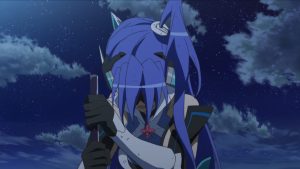 The battle looks like it is near its end when Tsubasa is knocked to the ground. The mystery girl taunts her, saying that Tsubasa isn’t even the reason she’s there. Really, she came to capture Hibiki, but she doesn’t say why. In response, Tsubasa vows to defeat the mystery girl before pinning her shadow to the ground with a small dagger. She then make a point of reminding Hibiki just how far she’s willing to go to achieve victory against the Noise and this new opponent.
The battle looks like it is near its end when Tsubasa is knocked to the ground. The mystery girl taunts her, saying that Tsubasa isn’t even the reason she’s there. Really, she came to capture Hibiki, but she doesn’t say why. In response, Tsubasa vows to defeat the mystery girl before pinning her shadow to the ground with a small dagger. She then make a point of reminding Hibiki just how far she’s willing to go to achieve victory against the Noise and this new opponent.
Then, Tsubasa sings. She puts away her sword and slowly walks towards the mystery girl while singing her Superb Song. Blood flows from her mouth as she looks the frightened mystery girl directly in the eyes. The resulting blast destroys all the nearby Noise and seemingly badly injures the girl as well. The mystery girl flees just before Genjuro and Ryoko arrive. Tsubasa claims to be all right. That, as a sword, she won’t break now… but her claims are obviously a lie as there is a pool of her own blood forming below her all flowing from her mouth and even her eyes. A moment later Tsubasa falls to the ground.
 We find out that singing a Superb Song is not necessarily fatal as Tsubasa is apparently rushed to a hospital and the doctors manage to save her life. It seems like she might even be able to fully recover in time. Meanwhile, Hibiki is beating herself up over her role in Tsubasa’s fall. She finally realizes that offering to replace Kanade was the wrong thing to do. Ogawa helps her understand more about Tsubasa and her need to fight after Kanade’s death.
We find out that singing a Superb Song is not necessarily fatal as Tsubasa is apparently rushed to a hospital and the doctors manage to save her life. It seems like she might even be able to fully recover in time. Meanwhile, Hibiki is beating herself up over her role in Tsubasa’s fall. She finally realizes that offering to replace Kanade was the wrong thing to do. Ogawa helps her understand more about Tsubasa and her need to fight after Kanade’s death.
Later we see that Hibiki is still working through the suffering Tsubasa must have been going through since Kanade’s death. First in a meeting with 2nd Division’s leaders, and then on the roof overlooking the hospital where Miku helps encourage her. Finally, after a month or more of trying to be Kanade’s replacement, Hibiki decides to be herself and protect the things she cherishes as herself.
 We then get a fantastic training montage as Hibiki trains hard under Genjuro all while Miku watches in secret from the shadows. The episode actually ends on something of an ominous note as Hibiki promises Miku that she’ll never keep a secret from her…
We then get a fantastic training montage as Hibiki trains hard under Genjuro all while Miku watches in secret from the shadows. The episode actually ends on something of an ominous note as Hibiki promises Miku that she’ll never keep a secret from her…
Episode Impressions:
 Although I enjoyed the first three episodes of Symphogear, this is the one that really sold me on the series. Kanade’s destructive determination to kill the monsters that murdered her family was really impactful. But so was her shift to the calm, encouraging Kanade that we knew from the first episode.
Although I enjoyed the first three episodes of Symphogear, this is the one that really sold me on the series. Kanade’s destructive determination to kill the monsters that murdered her family was really impactful. But so was her shift to the calm, encouraging Kanade that we knew from the first episode.
Tsubasa’s fight with the mystery girl was impressive. There was some nice choreography in there. Tsubasa’s solution was chilling and had a great buildup.
Afterwards, it was great to see Hibiki really work towards understanding Tsubasa’s thinking and her own role in Tsubasa’s fall. That Hibiki’s solution was to actually train for her role as a Symphogear user for the first time was great to see. There’s a good number of easter eggs in that training montage and it had me laughing out loud.
Specific Scenes I Loved:
 Kanade trying to sync with Gungnir. Her near insanity. Her willingness to risk death for the slim chance at getting her revenge. That bloody hand and handprint as she finally synced up with the relic. Her sheer frightening joy when she completed her first transformation and knew she could finally kill Noise. It was a great scene. Like I said above, it’s the scene that sold me on Symphogear as a show. The writing and emotions there had me convinced the show really knew what it was doing.
Kanade trying to sync with Gungnir. Her near insanity. Her willingness to risk death for the slim chance at getting her revenge. That bloody hand and handprint as she finally synced up with the relic. Her sheer frightening joy when she completed her first transformation and knew she could finally kill Noise. It was a great scene. Like I said above, it’s the scene that sold me on Symphogear as a show. The writing and emotions there had me convinced the show really knew what it was doing.
Tsubasa’s fight with the mystery girl. The Blue Flash attack being blocked and redirected. Tsubasa’s sword skills being bested. And her comeback with Shadow Weaving and her Superb Song. There was a great flow to the entire battle and also some great tension near the end. The musical buildup to the Superb Song was almost a little frightening. I knew that Tsubasa’s chilling, echoing song was coming, and I knew what singing it had done to Kanade. There was at least a chance Tsubasa might actually die which made it a very impactful scene.
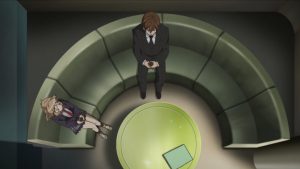 Hibiki’s talk with Ogawa. Especially that moment where Hibiki asks if Kanade died to save her and Ogawa pauses and then takes a sip of his drink instead of answering. Brad Bird once said it about his movie The Incredible, but I think it’s true of every medium: One of the hardest things to do well is just having two people in a room talking about serious things. No jokes. No quips. No fights or explosions. To get points across and keep things interesting requires good writing and good characters. This scene had both. And this scene sets Hibiki and Tsubasa down a path towards a better relationship, which is nice.
Hibiki’s talk with Ogawa. Especially that moment where Hibiki asks if Kanade died to save her and Ogawa pauses and then takes a sip of his drink instead of answering. Brad Bird once said it about his movie The Incredible, but I think it’s true of every medium: One of the hardest things to do well is just having two people in a room talking about serious things. No jokes. No quips. No fights or explosions. To get points across and keep things interesting requires good writing and good characters. This scene had both. And this scene sets Hibiki and Tsubasa down a path towards a better relationship, which is nice.
Hibiki’s training montage. I probably missed some references, but at the very least it has Hibiki and Genjuro dressed as Bruce Lee. It has them dressed as fighters from Street Fighter, too, among all its silly looking exercises. I loved it!
Songs In This Episode:
Zettō Ame no Habakiri – This song has the same meaning as before. It’s about Tsubasa grieving for and deriving determination from Kanade’s death. But now, it is directed at someone who might have played a role in that death. So, there’s another little layer of meaning on top of the dark themes already contained within Tsubasa’s iconic song.
Gekisou Gungnir – Hibiki’s song is used as the slow background music for her talk with Ogawa, and then as part of her training montage. A lot of meaning here? Maybe not. But Hibiki’s focus on bridging gaps and looking to the future does fit in with what she is trying to do with Tsubasa.
Themes In This Episode:
 The better world Kanade saw. The first theme we get in this episode comes from Kanade. Her initial, self-destructive rage at what the Noise did to her family and then later her revelation that her songs are useful for more than killing Noise. That they can help and inspire people, as well. I bet we’ll see more on this later, but it’s already pretty clear that Kanade shifted from someone only focused on revenge to a person who discovered a better way of living and was trying to help Tsubasa find that better way as well.
The better world Kanade saw. The first theme we get in this episode comes from Kanade. Her initial, self-destructive rage at what the Noise did to her family and then later her revelation that her songs are useful for more than killing Noise. That they can help and inspire people, as well. I bet we’ll see more on this later, but it’s already pretty clear that Kanade shifted from someone only focused on revenge to a person who discovered a better way of living and was trying to help Tsubasa find that better way as well.
If anything, Tsubasa is sorta in early Kanade’s place right now. We don’t know what her childhood was like except that she was present at 2nd Division even when she was younger. But now, and for the past two years, Tsubasa has been caught up in a slightly more controlled cycle of rage and despair caused by Kanade’s death.
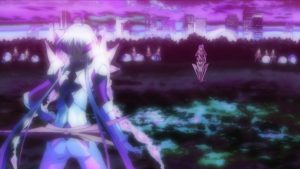 Tsubasa’s self sacrifice. I think we also got a little aspect of self sacrifice from Tsubasa. Was her Superb Song fully necessary? Could she have maybe retreated with Hibiki? Sure, she sang it to defeat the Noise and the mystery girl, but she also sang her Superb Song to make one final point to Hibiki about how Hibiki lacked determination to combat the Noise. It was almost a cruel jab, as if saying: “you’re so weak that I have to sacrifice my life to save yours… just like Kanade did.”
Tsubasa’s self sacrifice. I think we also got a little aspect of self sacrifice from Tsubasa. Was her Superb Song fully necessary? Could she have maybe retreated with Hibiki? Sure, she sang it to defeat the Noise and the mystery girl, but she also sang her Superb Song to make one final point to Hibiki about how Hibiki lacked determination to combat the Noise. It was almost a cruel jab, as if saying: “you’re so weak that I have to sacrifice my life to save yours… just like Kanade did.”
Hibiki finding her purpose. In the second half of the episode, Hibiki is finally able to come to understand both Tsubasa and herself. Ogawa helps her understand Tsubasa’s need to fight, and through that, Hibiki realizes just why it was so wrong to try and directly replace Kanade in Tsubasa’s life. It was never healthy for Tsubasa to channel her anger and sadness into nothing but fighting Noise, but for someone new to come along and try to fill that void without understanding it was only contributing to the problem.
 But Hibiki also learned something about herself. She’d already figured it out a bit, that she too had something she wanted to protect. She speaks it directly in this episode. “It might just be a tiny promise or my bland everyday life, but I want to become stronger to protect them and still be myself.” Even if she knew she wanted to use her Symphogear to protect people, Hibiki had not yet really acted to gain the skills necessary to do so. Sure, she was fairly powerful when she went into that little rage at not being able to see the meteor shower with Miku, but she hadn’t even tried training to improve her skills. Finally, she has committed herself to actually learning to wield her Symphogear effectively. I can’t wait to see the results of her training montage.
But Hibiki also learned something about herself. She’d already figured it out a bit, that she too had something she wanted to protect. She speaks it directly in this episode. “It might just be a tiny promise or my bland everyday life, but I want to become stronger to protect them and still be myself.” Even if she knew she wanted to use her Symphogear to protect people, Hibiki had not yet really acted to gain the skills necessary to do so. Sure, she was fairly powerful when she went into that little rage at not being able to see the meteor shower with Miku, but she hadn’t even tried training to improve her skills. Finally, she has committed herself to actually learning to wield her Symphogear effectively. I can’t wait to see the results of her training montage.
Finally, let’s think about the episode title: Falling Tears. There were a lot of tears that fell in this episode:
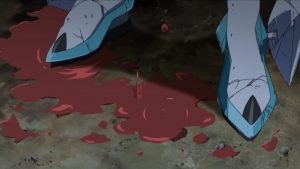 First we need to think about who hadn’t let any tears fall. Both Kanade in her enraged state, and Tsubasa after Kanade’s death refused to shed any tears. Kanade was in a mad rage for a long time. Tsubasa’s rage and despair was more channeled or maybe more controlled, but she too didn’t cry for almost two years after Kanade’s death.
First we need to think about who hadn’t let any tears fall. Both Kanade in her enraged state, and Tsubasa after Kanade’s death refused to shed any tears. Kanade was in a mad rage for a long time. Tsubasa’s rage and despair was more channeled or maybe more controlled, but she too didn’t cry for almost two years after Kanade’s death.
Next we have Tsubasa’s tears of blood flowing from her eyes after she sings her Superb Song. Her final statement before she collapses is her declaration of her current way of living. That she is a sword dedicated to defending people and that she will not break… which she must know is a lie. There’s blood flowing from her mouth and eyes and pooling at her feet. Maybe she is letting tears fall for herself, knowing that she has failed even in her desperate role of self sacrifice?
Then there’s Hibiki’s tears as she finally grasps the realization of Tsubasa’s cruel fate. Hibiki feels bad about what she’s done and at her lack of understanding. But, she isn’t crying for herself, rather she is crying at the tragic situation Tsubasa has been forced to live with the past few years.
 Hibiki also sheds tears of joy as she and Miku share a moment of friendship on the roof. These kind of tears are important, too! Not all tears come from sadness and despair.
Hibiki also sheds tears of joy as she and Miku share a moment of friendship on the roof. These kind of tears are important, too! Not all tears come from sadness and despair.
There’s one last instance of tears that’s a bit more subtle because its heard rather than seen. Hibiki’s Symphogear song, Gekisou Gungnir, includes a line that says something like: “I have no time to shed tears, I have things I want to protect” Unlike Tsubasa’s song, Hibiki’s has never been about channeling rage and despair. It’s always been an uplifting song of looking to the future and helping others. Tsubasa and Kanade refused to shed tears because to do so would be to show weakness or admit their sadness. We’ve seen Hibiki cry plenty, but the times she refuses to cry aren’t because she is holding in her sadness, but because she’s putting it aside to help others. Hibiki has been free to cry when she’s needed to while Kanade and Tsubasa weren’t. It’s an interesting distinction.
Special Attacks In This Episode:
Things You Should Pay Attention To:
Zwei Wing wasn’t formed by 2nd Division to fight the Noise, it was formed by Kanade, and to a much lesser extent Tsubasa, as a way to use their singing to help encourage people.
With enough experimentation and drugs, people who are not attuned to a relic can be made to be compatible with them to the point that the can summon Symphogear armor.
There is an enemy side to this conflict beyond the unthinking Noise. It was the mystery girl’s goal to capture Hibiki alive.
Miku now knows Hibiki is keeping some secrets from her.
Moment By Moment Notes:
0:00 – Five years ago, so three years before the concert tragedy.
0:18 – Wow! That’s Kanade, and she is angry and cursing! And the survivor of a Noise attack! Was she somewhere with her family digging for relics? Or just transporting one?
0:29 – So it was probably a trip to see a dig site?
0:39 – Wow, she is so different from the calm, collected Kanade that we’ve seen! She is angry to the point of being crazed!
1:29 – So Kanade had to take part in a bunch of risky experiments before she could use her Symphogear?
1:41 – Wow… that is not gentle!
2:36 – She is dying! She is willing to die for the slimmest chance to fight the Noise. (Which is still different from the Kanade we knew…)
2:54 – That bloody hand print. This was the real moment I knew Symphogear was an all time great anime.
3:24 – So… Kanade’s compatibility came from experiments and dangerous drugs while Tsubasa could sync with her Symphogear naturally?
3:54 – Last Meteor (and Kanade is still crazed!)
4:18 – Something changed with Kanade that day. This is where she starts becoming the calm, wise Kanade that we knew.
4:58 – So that’s how they went from strictly warriors to performers.
6:13 – This is a battlefield. “I think we’re going to get along quite well.” :p
6:26 – Blue Flash
7:11 – Not only can this person fight Tsubasa to a standstill (thanks to a fully powered Relic?) she is somehow summoning Noise?! Creatures that, as far as we know, are the largest threat to humanity ever!
7:55 – The goal was to abduct Hibiki?? Why?
8:09 – Shedding Tears (Is it really a different attack name??) – No, its the same text as before… not sure why the subtitles are different…
8:29 – Hibiki’s armed gear won’t appear.
9:23 – Nirvana Gedon
10:19 – Shadow Weaving – Did Tsubasa pin the girl with that little knife she tossed up in the air?!
11:06 – Tsubasa’s Superb Song. (The musical build up to it was amazing as well!)
11:43 – That blood. Just like Kanade. This is killing Tsubasa!
12:17 – The enemy survived!
12:42 – Oh wow… she is really messed up. And she falls.
13:13 – So singing a Superb Song isn’t a 100% death sentence. At least not if medical care is nearby?
14:45 – The lack of answer is a yes in it’s own way. Yes, Kanade died to save Hibiki. And everyone knows it.
15:29 – More tears. Whose tears is the episode title referring to? Tsubasa’s? Or Hibiki’s?
15:44 – Finally, Hibiki understands the pain she was putting Tsubasa through.
16:20 – Wow. What a powerful request.
16:47 – Drowning in the depth of despair?
18:09 – More shedding tears. More realizations.
19:22 – Miku is the best.
20:55 – More tears. But very different from the rest of the episode. These are tears of joy!
22:15 – Miku is watching Hibiki train.
22:30 – Even here, in Hibiki’s lyrics, we have a reference to shedding tears. In this case, she has no time to shed them because she has things she wants to protect.
23:36 – Hibiki’s lie about not hiding things could be trouble!
AniManga Picture Challenge Week 3 - Summer Festivals
Week 3 of the #AniMangaPictureChallenge is complete! Big thanks to CT for suggesting #anime and #manga Summer Festivals.
Rei - Giji Harem
My Little Ponfarr - The Quintessential Quintuplets
Anime Animals アニメの動物 - Miss Kobayashi's Dragon Maid
chikorita157 - The Demon Girl Next Door
Ragashingo - Summertime Rendering
Anicast - The Melancholy of Haruhi Suzumiya
CT - Rama 1/2
Symphogear Episode 03: Passing in the Night
Episode Summary:
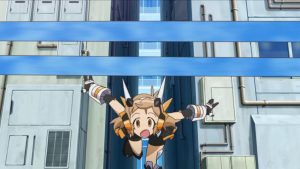 For the past month, Hibiki and Tsubasa have been fighting the Noise, but they still haven’t been able to get along. Their fights against the Noise mostly seem to involve Tsubasa slicing through the enemies while Hibiki tries to fight but mostly ends up running from attacks or getting knocked around.
For the past month, Hibiki and Tsubasa have been fighting the Noise, but they still haven’t been able to get along. Their fights against the Noise mostly seem to involve Tsubasa slicing through the enemies while Hibiki tries to fight but mostly ends up running from attacks or getting knocked around.
Back at her dorm with Miku, we find Hibiki trying to stay awake as she is writing a report on the Noise, of all things. But really, Hibiki is remembering the time she and Tsubasa almost fought.
In Hibiki’s flashback, Tsubasa insist that she doesn’t accept Hibiki’s attempts to replace Kanade at all. She says hell will freeze over before she accepts Hibiki and then jumps high in the air and launches one of her most powerful attacks at Hibiki! But right before her “Heaven’t Wrath” connects, she is stopped by a powerful punch from… Genjuro?!
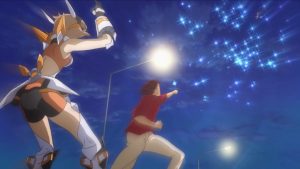 Genjuro’s attack rips the road up and sends Tsubasa flying. In the aftermath, water spews from a broken pipe drenching Tsubasa and helping cover the tears now flowing from her eyes. Hibiki once again tries to console Tsubasa by saying she will do her best to replace Kanade… which is the exact wrong thing to say… and earns Hibiki a well-deserved, angry, tearful slap from Tsubasa. It’s only a month later during her evening daydream that Hibiki finally realizes why Tsubasa was crying.
Genjuro’s attack rips the road up and sends Tsubasa flying. In the aftermath, water spews from a broken pipe drenching Tsubasa and helping cover the tears now flowing from her eyes. Hibiki once again tries to console Tsubasa by saying she will do her best to replace Kanade… which is the exact wrong thing to say… and earns Hibiki a well-deserved, angry, tearful slap from Tsubasa. It’s only a month later during her evening daydream that Hibiki finally realizes why Tsubasa was crying.
That same evening we see Tsubasa reliving her memory of Kanade’s final moments. She is there at the stadium again holding a near comatose Kanade in her arms. Instead of impactful words of wisdom, all Tsubasa receives from Kanade are pained, glassy-eyed babbles before Kanade’s body crumbles. In the present, we find that Tsubasa blames herself and her own lack of strength for Kanade’s death.
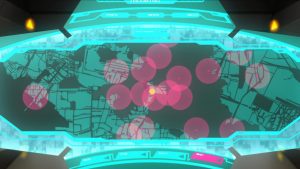 Both Hibiki and Tsubasa are called to 2nd Division headquarters for a new briefing on the Noise attacks. We learn that the Noise were first recognized by the world 13 years ago, but have existed all the way back to ancient times. All the recent attacks have been around the school, and Ryoko wonders if someone might be controlling the Noise. Tsubasa thinks that they are trying to get to Durandal, an almost completely intact relic stored below headquarters. We’re told it is much more powerful than the Symphogears Tsubasa and Hibiki wear since their relics are just mere fragments. Interestingly, it seems that an intact relic can be used by more than just the limited few Attuned who can operate a Symphogear. If 2nd Division could activate Durandal, anybody could use it.
Both Hibiki and Tsubasa are called to 2nd Division headquarters for a new briefing on the Noise attacks. We learn that the Noise were first recognized by the world 13 years ago, but have existed all the way back to ancient times. All the recent attacks have been around the school, and Ryoko wonders if someone might be controlling the Noise. Tsubasa thinks that they are trying to get to Durandal, an almost completely intact relic stored below headquarters. We’re told it is much more powerful than the Symphogears Tsubasa and Hibiki wear since their relics are just mere fragments. Interestingly, it seems that an intact relic can be used by more than just the limited few Attuned who can operate a Symphogear. If 2nd Division could activate Durandal, anybody could use it.
 Tsubasa leaves with Ogawa to work on her album, once again noting her goal to have no emotions, while Hibiki stays with the others where Ryoko actively flirts with her! More importantly, we find that the headquarters and its mix of modern and ancient technology was designed by Ryoko same as the Symphogears. Meaning that headquarters should be safe from all Noise attacks.
Tsubasa leaves with Ogawa to work on her album, once again noting her goal to have no emotions, while Hibiki stays with the others where Ryoko actively flirts with her! More importantly, we find that the headquarters and its mix of modern and ancient technology was designed by Ryoko same as the Symphogears. Meaning that headquarters should be safe from all Noise attacks.
At school the next day, Hibiki finally finishes her report and it is accepted by her teachers leaving Hibiki free to see a meteor shower with Miku that evening. Both are excited to finally have time to spend together, but then a Noise outbreak calls Hibiki away and she has to cancel her plans with Miku. Frustrated and angry, Hibiki tears into the Noise, quite literally at one point, showing an aggression we haven’t seen from her before. It’s almost a bit scary as she chases down one final Noise that escapes the subway tunnel they’ve been fighting in.
 The Noise is about to get away when Tsubasa drops in like a shooting star and destroys it from the air. Hibiki tries once more to get through to Tsubasa, saying that she too has somethings she wants to protect, but before the two have any chance to talk, someone new interrupts them! The new girl that appears is wearing the Nehushtan armor that was stolen during the concert two years ago!
The Noise is about to get away when Tsubasa drops in like a shooting star and destroys it from the air. Hibiki tries once more to get through to Tsubasa, saying that she too has somethings she wants to protect, but before the two have any chance to talk, someone new interrupts them! The new girl that appears is wearing the Nehushtan armor that was stolen during the concert two years ago!
Episode Impressions:
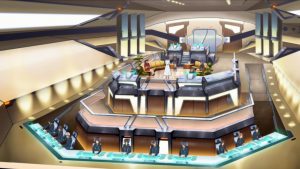 This was another episode pretty heavy on info dumping. We learn about how the Noise have probably always existed, how 2nd Division is protecting a powerful relic, and a little more about why Tsubasa has grown so cold and emotionless since Kanade’s death. We also see that Hibiki is having her own issues with being a superheroine, but she has finally started to realize why Tsubasa won’t fight along side her.
This was another episode pretty heavy on info dumping. We learn about how the Noise have probably always existed, how 2nd Division is protecting a powerful relic, and a little more about why Tsubasa has grown so cold and emotionless since Kanade’s death. We also see that Hibiki is having her own issues with being a superheroine, but she has finally started to realize why Tsubasa won’t fight along side her.
In a lot of ways, it felt like this episode set up things to come. Surely, we’ll hear more about Durandal, for instance. It also seems likely that 2nd Division headquarters will be attacked directly. Oh, and we end on a cliffhanger with a new girl wearing the armor stolen from the concert.
Specific Scenes I Loved:
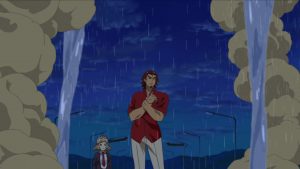 Genjuro stopping Tusbasa’s rocket sword kick aimed at Hibiki! How the heck did he do that?! Maybe he didn’t… at least not entirely? I’m pretty sure that even though Genjuro did block it temporarily, it’s also true that Tsubasa cancelled her attack in order not to hurt him. Look at the way her giant sword vanishes and she sorta falls awkwardly away before the street is ripped up.
Genjuro stopping Tusbasa’s rocket sword kick aimed at Hibiki! How the heck did he do that?! Maybe he didn’t… at least not entirely? I’m pretty sure that even though Genjuro did block it temporarily, it’s also true that Tsubasa cancelled her attack in order not to hurt him. Look at the way her giant sword vanishes and she sorta falls awkwardly away before the street is ripped up.
The scene where Hibiki is on the school lawn working on her report while accepting friendship and food from every direction. It’s just a cute scene.
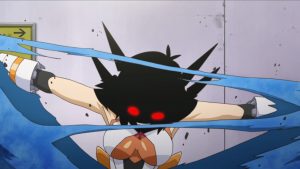 Hibiki going berserk against the Noise in the subway! She stomps one’s face in! She rips another’s head off! She is not happy. We focus a lot on Tsubasa’s emotional state, but I wonder if Hibiki’s might play a role in future episodes. A stoic and controlled Tsubasa vs an out of control Hibiki?
Hibiki going berserk against the Noise in the subway! She stomps one’s face in! She rips another’s head off! She is not happy. We focus a lot on Tsubasa’s emotional state, but I wonder if Hibiki’s might play a role in future episodes. A stoic and controlled Tsubasa vs an out of control Hibiki?
The appearance of an actual villain. We don’t know who is in that armor, but we seem to have someone willing to talk and taunt at our heroines.
Songs In This Episode:
Zettō Ame no Habakiri (Ame no Habakiri, the Ultimate Blade) – For Tsubasa, we get her theme song at the beginning and end of the episode mostly just as a show of her power. The meaning hasn’t really changed.
Gekisou Gungnir (Gungnir, the Striking Spear) – For Hibiki, I can’t help but note the cruel irony Hibiki’s song talks about never letting go of someone’s hand when just hours ago Hibiki was forced to leave Miku behind.
Themes In This Episode:
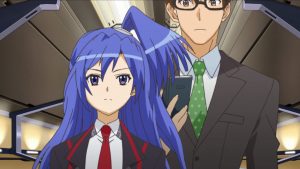 Tsubasa as a sword. After Kanade’s death, Tsubasa seems to have closed herself off to everyone. She keeps referring to herself as a sword or a weapon. She sees herself as someone who only exists to fight the Noise and who has no need for emotions. And yet… we see that Tsubasa still has those emotions she does not want. She attempts to fight Hibiki because she is so angry at the cheerful girl’s insistence that she can replace Kanade. She seems to often think back to the moment where Kanade died. She insists she cannot even be upset, but she clearly is often mad at everyone when she isn’t able to hide her emotions from the world. Just fighting against the Noise is not enough for Tsubasa, but she hasn’t been able to admit that she needs more than fighting to be a full person.
Tsubasa as a sword. After Kanade’s death, Tsubasa seems to have closed herself off to everyone. She keeps referring to herself as a sword or a weapon. She sees herself as someone who only exists to fight the Noise and who has no need for emotions. And yet… we see that Tsubasa still has those emotions she does not want. She attempts to fight Hibiki because she is so angry at the cheerful girl’s insistence that she can replace Kanade. She seems to often think back to the moment where Kanade died. She insists she cannot even be upset, but she clearly is often mad at everyone when she isn’t able to hide her emotions from the world. Just fighting against the Noise is not enough for Tsubasa, but she hasn’t been able to admit that she needs more than fighting to be a full person.
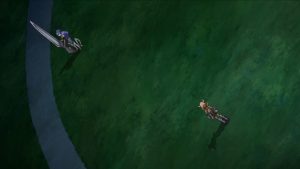 Things Hibiki wants to protect. Hibiki isn’t helping things. It has taken her more than a month to start to grasp why Tsubasa refuses to fight along side her. I think what Hibiki says near the end, that she too has things she wants to protect, is her first real attempt to reach out to Tsubasa. It may not be the best attempt, but Hibiki seems to have realized that one of the reasons Tsubasa is so cold towards her is that Tsubasa thinks she has no real reason for being a Symphogear user. Of course, the only response that declaration got from Tsubasa was an emotionless glare, so we don’t know if Hibiki got through at all.
Things Hibiki wants to protect. Hibiki isn’t helping things. It has taken her more than a month to start to grasp why Tsubasa refuses to fight along side her. I think what Hibiki says near the end, that she too has things she wants to protect, is her first real attempt to reach out to Tsubasa. It may not be the best attempt, but Hibiki seems to have realized that one of the reasons Tsubasa is so cold towards her is that Tsubasa thinks she has no real reason for being a Symphogear user. Of course, the only response that declaration got from Tsubasa was an emotionless glare, so we don’t know if Hibiki got through at all.
Hibiki lying to Miku. Over and over again Hibiki is abandoning Miku to fight the Noise. It is making both of them frustrated and we’ve already seen Hibiki take out that frustration on the Noise. It was actually kinda scary watching Hibiki literally tear apart the creatures that pose an unstoppable threat to humanity! But we also have to wonder how much longer Miku will keep covering for Hibiki. Or what might happen if Miku finds out what Hibiki is doing. Miku also seems like a good target to capture in order to force Hibiki to do something…
Special Attacks In This Episode:
Things You Should Pay Attention To:
Ryoko notes that Hibiki has caught her interest.
In addition to being based on their relic fragments, each Symphogear users’ armed gears embody their will to fight on the battlefield. Tsubasa sees herself as a weapon, as a sword, so she is heavily sword themed and her armed gear is a large sword that she uses in various special attacks. Will Hibiki’s armed gear just be Kanade’s spear?
That headquarters was designed by Ryoko with pagan and modern technologies and is thought to be a completely safe place seems like it’ll come back up later.
Moment By Moment Notes:
0:14 – A montage of Hibiki not doing so well. But, then, Tsubasa probably isn’t going out of her way to teach her, either.
0:36 – They’ve been this way for an entire month!
2:16 – Miku is researching meteor showers while Hibiki is writing a report on the Noise.
2:47 – Hecke Hetchara (I’m fine, no big deal).
3:26 – Hibiki has really caught Sakarai’s attention
3:59 – An armed gear embodies each’s user’s will to fight on the battlefield.
4:55 – Heaven’s Wrath – Wow, Tsubasa jumps high, throws her sword out which changes to building sized, then both her and the sword light up for a giant rocket kick!
4:58 – Wow! Genjuro just punched and put up a shield that destroyed Tsubasa’s giant sword to pieces and destroyed a large section of the road sending Tsubasa flying!
5:31 – Genjuro likes his movies.
6:12 – Wow, exactly the wrong thing to say! That slap is well deserved!
7:02 – Ouch… she couldn’t even see Tsubasa as she died. And what an odd, unfulfilling last line. (Totally excellent… just not what Tsubasa needed.) 🙁
10:05 – Ha, she was just working on a report!
10:14 – What happened 13 years ago? Is that just when the world could prove Noise exists?
11:21 – So Durandal (almost certainly a sword, it’s a sword from European legend) is going to be much more powerful than the Symphogear?
13:37 – Pagan and modern technology?
13:59 – That Tsubasa was approached by a British record company was mentioned on the news before…
14:46 – “Swords have no such emotions”
14:44 – Whoa!! Sakuri… that’s way over the line isn’t it!
15:18 – Hibiki thinks she is cursed.
15:34 – This isn’t an anime.
15:55 – Miku is the best. This time for helping with homework.
16:40 – The idea of seeing the shooting starts keeps coming up again and again.
16:57 – Miku was on the track team.
18:11 – The Noise may be an unstoppable enemy of humanity, but I’d run if I saw a high school girl turn and stare at me like that!
18:41 – One thing I’ve been noticing is that they always show the wave of energy released after a Symphogear user transforms… Always show it hitting the Noise… I wonder why?
2020: Whoa! Hibiki getting a little dark here. (And literally!?) Not just about not seeing the stars, but about losing her ordinary life because of the Noise.
21:06 – Tsubasa?! It’s her song!
21:30 – “I have things I want to protect, too!” This is less Hibiki realizing that she has things to protect… she wants to protect everyone… and more her trying to connect with Tsubasa.
21:48 – A new voice. Our first speaking villain?
22:01 – And this girl is wearing the Nehushtan armor? Was she involved in the attack two years ago? Was she involved in Kanade’s death?!
AniManga Picture Challenge Week 2 - Senior Citizens
Week 2 of the #AniMangaPictureChallenge is complete! This week, we highlighted our favorite Senior Citizens across #anime and #manga.
My Little Ponfarr - Handyman Saito In Another World
Anicasts - Laid Back Camp
Ragashingo - The World is Still Beautiful
Mole - Barakamon
Anime Animals アニメの動物 - Grandpa and Grandma Turn Young Again
Nikelui - Cyborg Grandpa G
chikorita157 - Slow Start
Retro Goth Bunny - Damedol and the Only Fan
SophiaHoppia - Haikyuu
Lúmëcolca - Shadow Skill
Symphogear Episode 02: Noise and Disharmony
Episode Summary:
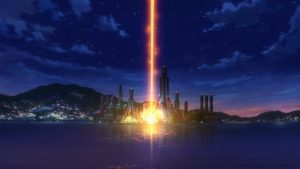 We rejoin the action from last episode with Hibiki completing her transformation sequence. She is now clad in the same type of armor that Kanade wore two years ago. Even the instruments at 2nd Division headquarters identify the signature of her armor as Gungnir, much to everyone’s surprise!
We rejoin the action from last episode with Hibiki completing her transformation sequence. She is now clad in the same type of armor that Kanade wore two years ago. Even the instruments at 2nd Division headquarters identify the signature of her armor as Gungnir, much to everyone’s surprise!
A new song springs to Hibiki’s lips as she takes hold of the girl she’s been trying so hard to protect. Hibiki makes a superhuman leap off the top of the building she and the girl were on and lands unharmed on the ground far below. From there, she manages to first evade and then even fight back against the Noise. Where before, the Noise would have turned Hibiki to ash on contact, now Hibiki is even able to punch one with no problem. Hibiki clearly doesn’t have a feel for her new powers, though, as she crashes into buildings left and right unintentionally as she tries to get away. Despite that, she manages to keep herself and the little girl in one piece until Tsubasa can make a flashy entrance.
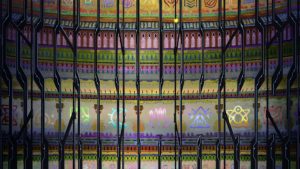 Tsubasa easily deals with the Noise, but then she and the staff from 2nd Division arrest Hibiki! They take her back to their headquarters which, it turns out, is located below Hibiki’s school, Lydian Private Music Academy. Although Tsubasa treats the moment as a somber, serious one, Genjuro and the others at headquarters upend the serious mood by throwing Hibiki a surprise welcome party.
Tsubasa easily deals with the Noise, but then she and the staff from 2nd Division arrest Hibiki! They take her back to their headquarters which, it turns out, is located below Hibiki’s school, Lydian Private Music Academy. Although Tsubasa treats the moment as a somber, serious one, Genjuro and the others at headquarters upend the serious mood by throwing Hibiki a surprise welcome party.
Hibiki says an awkward hello to everyone, but is quickly carted off by Ryoko for a medical exam. Hibiki returns home to her dorm that evening worn out only to find a worried Miku waiting for her. That night, as the two fall asleep together, Hibiki tells Miku not to worry to which Miku responds that of course she is going to worry over her friend. Unfortunately, Hibiki is not allowed to tell Miku the truth of what happened.
The next day, we see that Tsubasa is not at all happy with the fact that Hibiki has somehow inherited Kanade’s powers. Back at school, Hibiki wants to go eating with her friends but instead has to report back to 2nd Division to get the results of her medical examination and an explanation of her powers.
 It turns out that Ryoko Sakurai, the self described brains of 2nd Division, crafted special pendants from fragments of ancient relics which can only be used by a small number of Attuned individuals. They use songs to harness the power of these relics and form Symphogear armor. This special armor lets its user fight against the Noise who are impervious to seemingly all other forms of attack.
It turns out that Ryoko Sakurai, the self described brains of 2nd Division, crafted special pendants from fragments of ancient relics which can only be used by a small number of Attuned individuals. They use songs to harness the power of these relics and form Symphogear armor. This special armor lets its user fight against the Noise who are impervious to seemingly all other forms of attack.
We further learn that the reason Hibiki can transform, even without a Relic pendant, is that she still has tiny pieces of Kanade’s Gungnir embedded within her from the Noise attack two years ago. Upon learning this, Tsubasa leaves the room, unable to handle her mixture of outrage and grief. Hibiki soon follows her and joyfully promises to help her fight the Noise, not realizing that she herself is part of the reason Tsubasa is so distraught.
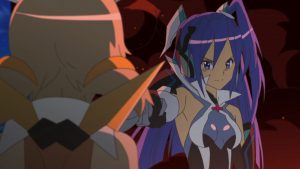 At that moment a collection of Noise appear nearby and both Tsubasa and Hibiki go to confront them. Tsubasa engages a giant noise that forms when a bunch of smaller ones merge together. Hibiki manages to help out a little before Tsubasa destroys the giant creature.
At that moment a collection of Noise appear nearby and both Tsubasa and Hibiki go to confront them. Tsubasa engages a giant noise that forms when a bunch of smaller ones merge together. Hibiki manages to help out a little before Tsubasa destroys the giant creature.
In the aftermath, Hibiki begs Tsubasa to be allowed to fight alongside her, to which Tsubasa aims her sword at Hibiki and angrily says that yes, the two of them really should fight…
Episode Impressions:
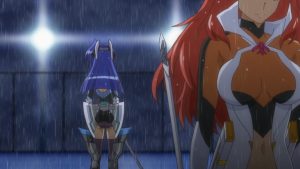 This was a rather subdued, exposition-heavy episode. We got a few minutes of combat at the beginning and end, but for the most part this episode was about two things: Explaining how the Symphogear armor works, and showing us Tsubasa’s mental state following Kanade’s death two years prior.
This was a rather subdued, exposition-heavy episode. We got a few minutes of combat at the beginning and end, but for the most part this episode was about two things: Explaining how the Symphogear armor works, and showing us Tsubasa’s mental state following Kanade’s death two years prior.
I like that the Symphogear armors are, in essence, technological. They harness a not very well understood power, sure, but they do so via technology. That Hibiki and most others barely understand how it works doesn’t really matter. Ryoko does, and that’s what’s important.
It was also good to see that the tragedy at the concert did have a major effect on Tsubasa. She doesn’t appear shy anymore, but she seems to have traded that shyness for a not entirely successful attempt at being an unfeeling warrior.
Specific Scenes I Loved:
 That brief moment as Hibiki holds out her hand to the little girl and cradles her in her arms. There’s a powerful strength there that I really liked.
That brief moment as Hibiki holds out her hand to the little girl and cradles her in her arms. There’s a powerful strength there that I really liked.
Tsubasa’s final, as yet unnamed, finishing attack when she arrived to rescue Hibiki. She took out that large noise by impaling it with a sword the size of a medium sized building!
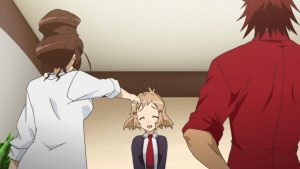 Hibiki’s admission that she barely understood any of the information she’d just been given about the Symphogear. Her voice and bemused, closed-eyed smile is just so cute in that moment!
Hibiki’s admission that she barely understood any of the information she’d just been given about the Symphogear. Her voice and bemused, closed-eyed smile is just so cute in that moment!
The way Tsubasa had to leave the room as they started talking about why Hibiki could summon a Symphogear. Tsubasa is clearly not doing ok with her loss.
Songs In This Episode:
Gekisou Gungnir (Gungnir, the Striking Spear) – This is Hibiki’s first song as a Symphogear users. Like most of the songs sung during combat, it is the voiced expression of her current thoughts and emotions.
Her song here is pretty neat. She’s basically saying that her singing is enough to bridge the communication gap between people that words sometimes cannot. And, that she’s going to use this newfound power of song to push forward into the future. Her song is kinda simple and straight forward, like she is. While there’s a line about not crying, this isn’t a song full of the pain / regret / suffering that Tsubasa’s was last episode. It’s a song of hope and bringing that message of hope to the future.
Also… I love the bagpipes it kicks off with!
Zettō Ame no Habakiri (Ame no Habakiri, the Ultimate Blade) – Tsubasa’s song continues to be awesome. I like its power and the way it feels like something spectacular and imposing is about to happen.
Themes In This Episode:
 Tsubasa vs Hibiki: One of the largest themes throughout this episode is Tsubasa’s reaction to Hibiki inheriting Kanade’s Symphogear. Tsubasa expressed the idea to herself that Hibiki is using a power that should still be Kanade’s. We also see something of a repeat of Kanade’s words about everything being ok as long as she and Tsubasa are together. Obviously, they aren’t together anymore… So, obviously things aren’t ok?
Tsubasa vs Hibiki: One of the largest themes throughout this episode is Tsubasa’s reaction to Hibiki inheriting Kanade’s Symphogear. Tsubasa expressed the idea to herself that Hibiki is using a power that should still be Kanade’s. We also see something of a repeat of Kanade’s words about everything being ok as long as she and Tsubasa are together. Obviously, they aren’t together anymore… So, obviously things aren’t ok?
Does Tsubasa see this as Hibiki’s fault? Would she rather Hibiki have died if it meant Kanade could have lived? Hopefully Tsubasa is a better person than that, but it’s possible that kind of negative response is her first, grief-tinted reaction to seeing Hibiki using Gungnir. Or, could it be that Tsubasa doesn’t think Hibiki is up for the hard, life threatening role of being a Symphogear user? Again, we just don’t really know because Tsubasa hasn’t really expressed her feelings at all.
 Hibiki, for her part, isn’t doing a lot to win Tsubasa over. Hibiki seems to think promising to fight the Noise alongside Tsubasa is what Tsubasa wants to hear, but it probably isn’t. Hibiki feels like a very energetic personality who tries to fix things by throwing herself into a situation, but so far Tsubasa doesn’t need help. She needs Hibiki to understand what Kanade’s death meant. Hibiki simply saying “I want to help!” isn’t enough. There’s emotions of sadness and grief radiating off of Tsubasa that Hibiki hasn’t even acknowledged yet. Things will probably stay bad between the two until Hibiki gets a clue.
Hibiki, for her part, isn’t doing a lot to win Tsubasa over. Hibiki seems to think promising to fight the Noise alongside Tsubasa is what Tsubasa wants to hear, but it probably isn’t. Hibiki feels like a very energetic personality who tries to fix things by throwing herself into a situation, but so far Tsubasa doesn’t need help. She needs Hibiki to understand what Kanade’s death meant. Hibiki simply saying “I want to help!” isn’t enough. There’s emotions of sadness and grief radiating off of Tsubasa that Hibiki hasn’t even acknowledged yet. Things will probably stay bad between the two until Hibiki gets a clue.
Tsubasa’s offer for herself and Hibiki to fight isn’t a good sign. I don’t think Tsubasa means to actually harm Hibiki, but she might try to scare her away. Or, Tsubasa might take her anger, grief, and frustration out on Hibiki. I think it’s too early for anyone to actually be injured in such a fight, but it is going to be interesting to see how this plays out.
Special Attacks In This Episode:
Things You Should Pay Attention To:
That the 2nd Division’s headquarters is built below Hibiki’s school and is a mixture of modern and ancient technology is interesting.
Symphogear relics don’t activate for just anyone and it takes more than someone just humming a song. This would mean those who can summon a Symphogear are special in some way.
Hibiki is converting the power of Gungnir directly instead of using a Symphogear pendant like Tsubasa and Kanade used.
Hibiki is not allowed to tell anyone, Miku included, about her new double life as a super heroine.
Both in this episode and in the first one, the Noise appeared somewhat near the school. Is there a reason for that? Because the headquarters is there?
Moment By Moment Notes:
0:09 – Aufwachen is German for waking up. So… an awakening waveform?
0:19 – Confirmation that Hibiki’s Symphogear is the same as Kanade’s
0:23 – The OP. Remember, we’ll dig into the song and imagery near the end of the season to avoid spoilers.
1:55 – Bagpipes?!
2:15 – I love that little moment where Hibiki reaches out her hand and the girl takes it. That hug Hibiki gives her is so protective while also being bad ass!
3:15 – Hibiki’s first punch!
3:29 – Wait… if military grade guns and missiles don’t affect the noise, then isn’t that a waste of a perfectly good motorcycle?!
4:00 – Blue Flash
4:09 – One Thousand Tears
4:31 – I did not expect a sword that big! But, aww, the attack didn’t get a name. 🙁
4:51 – And that, my friends, is a military grade vacuum cleaner! :p
5:28 – Not even a hint of a smile
7:28 – That moment the elevator emerges into the wider shaft is pretty cool!
8:03 – She’s worried how her picture will look with handcuffs. What a goof!
10:35 – Miku is the best. (This comment will appear frequently. I herby promise to always copy and paste it, every single time.)
12:01 – There’s nothing to fear while we’re together
12:08 – That gear is Kanade’s!
12:16 – I like the random girl playing the horn. It’d be so annoying, but kinda hilarious!
12:25 – Flower is a shop that serves okonomiyaki… which is kinda like pancakes but tends to have vegetables or other stuff layered on top. So… “pancake place” isn’t an exact translation here.
12:36 – Your life is like an anime character’s.
14:30 – So she didn’t just sing at random, the power of the Symphogear relic guided her singing or made her sing?
16:11 – So, there are still some tiny pieces of Kanade’s Gungnir in Hibiki. (Also… isn’t this close to the origin story of Iron Man?! :p)
18:33 – Yeah, Tsubasa doesn’t seem thrilled at that…
19:36 – I think it’s good that the show acknowledges how strange it is to put yourself in the way of unkillable monsters from another dimension…
19:54 – The echo from the emergency speakers is really good.
20:24 – Tsubasa’s first transformation sequence
21:21 – Blue Flash
21:58 – Wait… should fight together or fight against each other?!
22:34 – Huh. This ending animation is actually pretty disturbing! (We’ll talk about it later.)
AniManga Picture Challenge Week 1 - Summer Fun
The return of the #AniMangaPictureChallenge’s #AniMangaFoundIt
was a success. From exploring the outdoors, to visiting the beach or pool, to the classic yuri aquarium date, #anime and #manga offer great ways to beat the summer heat!
Thanks to all who participated and to all who enjoy this content each week. New topic tomorrow morning!
Anime Animals アニメの動物 - Teasing Master Takagi-san
My Little Ponfarr - Pseudo Harem
Retro Goth Bunny - Bloom Into You
Mole - Barakamon
CT - Rama 1/2
Anicast - The Melancholy of Haruhi Suzumiya
Ragashingo - Macross Frontier
Symphogear Episode 01: Beat of Awakening
Welcome to the Senki Zessho Symphogear Episode Guide. Symphogear is one of my favorite anime of all time and I’m thrilled to share it with you! First off, a quick programming note. For this season, we’ll be using the Deetruck fan subs. I recommend these because of the way they separate the many songs from the spoken dialogue during episodes.
Episode Summary:
 This first episode opens abruptly to the sound of heavy rainfall. We see a girl standing at a bus stop soaked by the rain. We soon see that she’s holding a bouquet of flowers… lilies, most likely… which is soon confirmed as she gets on a bus and travels to a traditional Japanese gravesite. Lilies, if you don’t know are associated with death and remembrance. Oddly, there is destruction all around her in every scene from the bus stop to the gravesite itself. Something bad has happened. Some sort of disaster! Along the way, the girl thinks of an old proverb about a cuckoo and the way it was thought to cough up blood as it sang. The girl narrates that her very best friend, the one whose grave she is apparently visiting, did much the same thing. That she sang on a battlefield even as blood spilled from her mouth!
This first episode opens abruptly to the sound of heavy rainfall. We see a girl standing at a bus stop soaked by the rain. We soon see that she’s holding a bouquet of flowers… lilies, most likely… which is soon confirmed as she gets on a bus and travels to a traditional Japanese gravesite. Lilies, if you don’t know are associated with death and remembrance. Oddly, there is destruction all around her in every scene from the bus stop to the gravesite itself. Something bad has happened. Some sort of disaster! Along the way, the girl thinks of an old proverb about a cuckoo and the way it was thought to cough up blood as it sang. The girl narrates that her very best friend, the one whose grave she is apparently visiting, did much the same thing. That she sang on a battlefield even as blood spilled from her mouth!
We cut back to two years prior. The girl that died, whose name we now know is Hibiki, is standing in line for a concert of some kind and her friend, who we now know as Miku, is apologizing for being unable to join her because her family is having to take a trip to visit an ailing aunt.
 We cut again, this time to the two singers of Zwei Wing who are about to give their concert. Blue-haired Tsubasa is sitting against a crate nervous and shy with her hand’s folded in worry. She is quickly approached by her partner, Kanade, who is much more relaxed and eager to go on stage. After a brief appearance by their manager, Genjuro, Kanade shares some words with Tsubasa. That she needs to be more flexible, that their audience won’t have much fun if they themselves aren’t having a good time. Pulled free of her shell, Tsubasa, too, is looking forward to performing in the concert. She and Kanade move forward hand in hand.
We cut again, this time to the two singers of Zwei Wing who are about to give their concert. Blue-haired Tsubasa is sitting against a crate nervous and shy with her hand’s folded in worry. She is quickly approached by her partner, Kanade, who is much more relaxed and eager to go on stage. After a brief appearance by their manager, Genjuro, Kanade shares some words with Tsubasa. That she needs to be more flexible, that their audience won’t have much fun if they themselves aren’t having a good time. Pulled free of her shell, Tsubasa, too, is looking forward to performing in the concert. She and Kanade move forward hand in hand.
Meanwhile, Genjuro and spunky, upbeat scientist Ryoko Sakurai are setting up some sort of experiment with a strangely shaped object labeled Nehushtan. There are strange projectors pointed at the object. When Genjuro said that the concert will decide the future of mankind, he might just have meant it!
 And now we hit the concert. The light dim, the impressive stadium-spanning stage is lit, and both Kanade and Tsubasa come falling from the heavens to an enthused landing as the crowd goes crazy. The two stand waving to their audience and start in on the impressively paced “Gyakkou no Flugel” (Backlit Wings). They dance and sing in perfect time to the melody until, partway through their song, the lights go out and the music swells and the roof of the stadium splits open into shards to showcase the sunset sky beyond! Our blond-haired girl, Hibiki, is having the time of her life at what is apparently her first concert.
And now we hit the concert. The light dim, the impressive stadium-spanning stage is lit, and both Kanade and Tsubasa come falling from the heavens to an enthused landing as the crowd goes crazy. The two stand waving to their audience and start in on the impressively paced “Gyakkou no Flugel” (Backlit Wings). They dance and sing in perfect time to the melody until, partway through their song, the lights go out and the music swells and the roof of the stadium splits open into shards to showcase the sunset sky beyond! Our blond-haired girl, Hibiki, is having the time of her life at what is apparently her first concert.
Back at the experiment, it appears that Zwei Wing’s song is charging or empowering the Nehushtan object and that everything is going well. The song ends and another begins, but this time something has gone wrong. The object being empowered grows unstable and an explosion rips apart the middle of the stadium. It appears that the experiment area collapses due to the explosion and that only Genjuro and perhaps a few others survived. Then, from above, come strange flying creatures that look like they don’t quite belong in our world. Both Kanade and the audience recognize these creatures as “Noise” and the concert-goers immediately panic and begin to flee. As they do so the Noise descend and start attacking the audience members. Each person touched is quickly and painfully turned to ash!
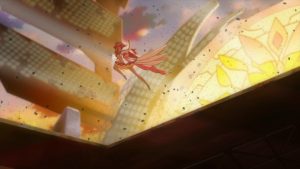 Unwilling to let the attack continue, Kanade leaps off the stage and sings a short, echoing chant. A pendant around her neck glows and suddenly she transforms into a form-fitting orange, white, and black suit adorned with armored pieces that form around her. In her hand is a giant spear. She begins singing a new song and, at the same time, beings cutting into the Noise left and right. She takes out individual Noise with powerful swipes of her spear and takes out dozens at a time with powerful ranged attacks. Following behind her is Tsubasa who has also transformed into a blue set of armor and is cutting apart the Noise with a nodachi.
Unwilling to let the attack continue, Kanade leaps off the stage and sings a short, echoing chant. A pendant around her neck glows and suddenly she transforms into a form-fitting orange, white, and black suit adorned with armored pieces that form around her. In her hand is a giant spear. She begins singing a new song and, at the same time, beings cutting into the Noise left and right. She takes out individual Noise with powerful swipes of her spear and takes out dozens at a time with powerful ranged attacks. Following behind her is Tsubasa who has also transformed into a blue set of armor and is cutting apart the Noise with a nodachi.
Back in the now empty bleachers, Hibiki has apparently become too shocked at the sight before her to flee. Something happens to Kanade and her power appears to dim. She even makes a comment to that effect, that she can’t go any farther. Above her, the rows of seating smash and crumble and send Hibiki tumbling painfully down to the ground floor of the stadium. The nearby Noise being rushing towards her only to be intercepted by Kanade who is then forced to block a spurt of vile liquid ejected at her by one of the building-sized Noise in front of her. Another Noise joins in and Kanade’s armor cracks and parts of it shatter. A few pieces are blown backwards and strike Hibiki directly in the chest! She falls to the ground in a pool of her own blood.
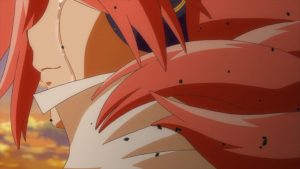 In a dramatic and chilling moment, Kanade rushes to the blond-haired girl’s side and urges her to keep on living before she then stands and walks calmly towards the large group of Noise arrayed in front of her. With a tear streaming down her face, Kanade lifts her crumbling spear high and sings a soft, chilling song even as Tsubasa yells in desperation for her not to. Back against the wall, our fading, glassy-eyed, Hibiki listens to the beautiful melody. A flow of blood escapes from Kanade’s lips as she finishes her song and then all the Noise present in the stadium are blown away in an instant. And, just like that, Kanade topples sideways to the ground.
In a dramatic and chilling moment, Kanade rushes to the blond-haired girl’s side and urges her to keep on living before she then stands and walks calmly towards the large group of Noise arrayed in front of her. With a tear streaming down her face, Kanade lifts her crumbling spear high and sings a soft, chilling song even as Tsubasa yells in desperation for her not to. Back against the wall, our fading, glassy-eyed, Hibiki listens to the beautiful melody. A flow of blood escapes from Kanade’s lips as she finishes her song and then all the Noise present in the stadium are blown away in an instant. And, just like that, Kanade topples sideways to the ground.
Our blond-haired girl is in bad shape. She’s barely able to keep her eyes open now, but she does so just long enough to see Tsubasa embracing her partner. Shockingly, Kanade’s entire body disintegrates and is blown away by the wind as Tsubasa cries painful tears above her. When Hibiki next awakens she is in the middle of an operating room, surprised that she is still alive.
 We jump forwards almost two years and find our blond-haired girl, whose full name is named Hibiki Tachibana, attending school with Miku. The two return to their rather spacious dorm room where we find that Hibiki has always had a thing for going far out of her way to help people. And that she choose to attend Lydian Private Music Academy along with Miku because it is the school Tsubasa attends. Two years prior, Hibiki didn’t even know who Zwei Wing were, but now she is a huge fan of Tsubasa’s who has continued her music career solo after Kanade’s death. We find that Hibiki isn’t actually sure of what she saw that day at the concert. She only knows that many people died and that she barely survived with a large scar on her chest.
We jump forwards almost two years and find our blond-haired girl, whose full name is named Hibiki Tachibana, attending school with Miku. The two return to their rather spacious dorm room where we find that Hibiki has always had a thing for going far out of her way to help people. And that she choose to attend Lydian Private Music Academy along with Miku because it is the school Tsubasa attends. Two years prior, Hibiki didn’t even know who Zwei Wing were, but now she is a huge fan of Tsubasa’s who has continued her music career solo after Kanade’s death. We find that Hibiki isn’t actually sure of what she saw that day at the concert. She only knows that many people died and that she barely survived with a large scar on her chest.
Elsewhere, members of the Japanese Self Defense Forces are engaging a group of Noise, but find that their bullets and missiles have no effect on the otherworldly creatures. But then, a helicopter flies low overhead and drops a serious, emotionless Tsubasa to the ground right in front of the Noise. Defying Genjuro’s orders, Tsubasa engages the enemies before her, and in an impressive display of power, she strikes them down with a quick combination of powerful close and long ranged attacks.
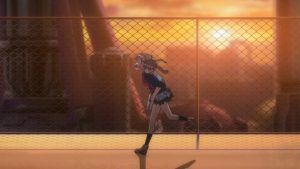 The next day, Hibiki finally gets her chance to meet Tsubasa, but their encounter doesn’t go like she hoped. Tsubasa, still emotionless, merely points out that Hibiki has some rice on her face before moving on. Later, Hibiki races to a music shop in the nearby city eager to pick up Tsubasa’s latest CD when disaster strikes. It seems the Noise have been rampaging nearby and have already killed several civilians. Hibiki hears a scream and runs to assist a little girl cornered by them. The two flee across a stream and up a highway as Hibiki remembers a little bit more of what happened to her at the concert. Hibiki and the girl manage to reach a high rooftop in what looks to be an industrial complex. For a moment it looks like they are safe, but then they see that the Noise have surrounded them.
The next day, Hibiki finally gets her chance to meet Tsubasa, but their encounter doesn’t go like she hoped. Tsubasa, still emotionless, merely points out that Hibiki has some rice on her face before moving on. Later, Hibiki races to a music shop in the nearby city eager to pick up Tsubasa’s latest CD when disaster strikes. It seems the Noise have been rampaging nearby and have already killed several civilians. Hibiki hears a scream and runs to assist a little girl cornered by them. The two flee across a stream and up a highway as Hibiki remembers a little bit more of what happened to her at the concert. Hibiki and the girl manage to reach a high rooftop in what looks to be an industrial complex. For a moment it looks like they are safe, but then they see that the Noise have surrounded them.
With the Noise nearly upon them, a familiar chant springs to Hibiki’s lips. Her voice echoes as she sings it and then she falls to her hands and knees as the same orange, white, and black armor that Kanade wore encases her! Hibiki stands up with a frightening look of power in her eyes as the episode ends.
Episode Impressions:
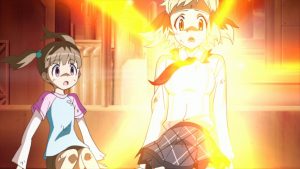 I thought this was a pretty strong opening episode. If it’s job was to get me hooked for a second episode, then I’d say it did a great job. The concert scene and battle scene was almost custom made for me seeing as I come from a Macross background where of course singing and combat go hand in hand. And Hibiki’s transformation was a great mini cliffhanger that promised more cool things to come.
I thought this was a pretty strong opening episode. If it’s job was to get me hooked for a second episode, then I’d say it did a great job. The concert scene and battle scene was almost custom made for me seeing as I come from a Macross background where of course singing and combat go hand in hand. And Hibiki’s transformation was a great mini cliffhanger that promised more cool things to come.
I also thought this episode did a good job establishing characters. Hibiki as the goof with a heart of gold, and Tsubasa as first a shy girl and then as a no-nonsense warrior. And I liked the way they did both of these. So much of Tsubasa’s character was established just by her sitting nervously in her cloak. And Hibiki, her little chant about buying the CD as she ran was almost all we needed from her.
 Technically the episode had a couple of blemishes. Both the bus Miku gets on and the oil tanker coming into port in the beginning just looked a bit off. A couple of the 3d camera moves in the concert scene were a bit unnatural, as well. But beyond that, the art, animation, sound, and music were all somewhere between good and excellent. If the show can keep itself at this level all the way through then I think it will be very enjoyable.
Technically the episode had a couple of blemishes. Both the bus Miku gets on and the oil tanker coming into port in the beginning just looked a bit off. A couple of the 3d camera moves in the concert scene were a bit unnatural, as well. But beyond that, the art, animation, sound, and music were all somewhere between good and excellent. If the show can keep itself at this level all the way through then I think it will be very enjoyable.
Specific Scenes I Loved:
 Kanade and Tsubasa’s introduction. All it took was a sit and a hug and a few words to set up Tsubasa’s reserved character and Kanade’s far more outgoing personality. Sure, Tsubasa’s declaration that they could do anything as long as they were together instantly made me fear things would end badly, but it was pretty cool seeing a relatively small amount of animation do so much work in establishing two characters.
Kanade and Tsubasa’s introduction. All it took was a sit and a hug and a few words to set up Tsubasa’s reserved character and Kanade’s far more outgoing personality. Sure, Tsubasa’s declaration that they could do anything as long as they were together instantly made me fear things would end badly, but it was pretty cool seeing a relatively small amount of animation do so much work in establishing two characters.
The concert, of course! Symphogear was produced by a studio called Satelight who has plenty of experience combining anime and music. Their work in this episode was near the top of their game with only the concert scenes in one of their previous series, specifically the Macross Frontier movies, potentially topping this one. Here, the hand drawn animation was downright excellent and the computer animated stadium in the background and camera movements that put the two together were pretty good, as well. The opening couple of shots of Kanade and Tsubasa dancing are a little stiff, a little unnatural in the way the camera moves in exactly one direction and doesn’t vary the speed of its movement much. These first few shots feel just a bit too mechanical, and the zooms are a bit too abrupt to start and stop. But the animation of Kanade and Tsubasa keeps up to even those somewhat jerky movements perfectly! That shot a little later on where the camera spins out into the audience is pretty darn cool. As a first try at a dynamic, engaging concert, this was pretty good, if maybe just a tad too ambitious for what they were able to pull off. But you can see the high bar they are aiming for. And they got pretty close to achieving it!
 That brief moment during the concert where the roof lights up with Kanade and Tsubasa’s colors then opens to reveal the sunset is surprisingly powerful. Great combination of animation and music.
That brief moment during the concert where the roof lights up with Kanade and Tsubasa’s colors then opens to reveal the sunset is surprisingly powerful. Great combination of animation and music.
The battle against the Noise at the concert. So many cool things happen so quickly. Kanade taking out dozens of Noise with her special attacks. Her and Tsubasa’s cool run towards the camera where they destroy the Noise standing in their way. Kanade’s Superb Song and the way it saves the day at the cost of her life.
Tsubasa’s present day fight against the Noise. She disobeys orders to engage, but there’s no sign that she finds much joy in her victory. She wasn’t in a revenge rage, either. It was more like she was fighting out of a sense of duty but without a sense of satisfaction. As if the duty was her only reason for fighting now. Also, note her “One Thousand Tears” attack. It looks very similar to Kanade’s “Stardust Foton”. I think it is basically the same attack performed by Tsubasa in tribute or remembrance of Kanade with a new name that expresses Tsubasa’s sorrowful feelings.
Hibiki’s flight from the Noise. She is doing everything she can to keep herself and the little girl alive and in doing so she remembers that similar order that Kanade gave her two years before.
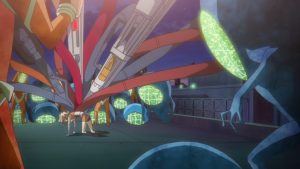 Hibiki’s first transformation. With Kanade, the transformation looked intentional and almost mechanical the way her armored pieces attached themselves to her. With Hibiki, all that techno-crap emerging from her body looked uncontrolled and painful! Is that the way she will transform every time, or was it a one off because it was her first transformation? Or do these heroines always transform like that and we just didn’t see it from Kanade or Tsubasa’s point of view?
Hibiki’s first transformation. With Kanade, the transformation looked intentional and almost mechanical the way her armored pieces attached themselves to her. With Hibiki, all that techno-crap emerging from her body looked uncontrolled and painful! Is that the way she will transform every time, or was it a one off because it was her first transformation? Or do these heroines always transform like that and we just didn’t see it from Kanade or Tsubasa’s point of view?
Songs In This Episode:
Gyakkou no Flugel (Backlit Wings) – This song was a fantastic choice to open the series and a great way to open the first concert. Its concert version is exciting, and it was great to see that the audience knew the song and was able to shout out some of the key lyrics. The song itself is about friendship, possibly even romance, and the way music can inspire people to support each other as they reach towards lofty goals together.
Orbital Beat – We only hear the very beginnings of this song as things start to go wrong at 2nd Division’s headquarters. Unfortunately, it is cut off by the explosion before we get to hear any of its lyrics. It’s actually a pretty cool song and we’ll get to hear it someday. For now, it is important to know that practically all of the voiced songs you hear in Symphogear have full length versions. Even Gyakkou no Flugel above was just a shortened two minute version of what is a five minute song.
Kimi to Iu Oto Kanade Tsukiru Made (Play Out the Sound That Is You to the Very End) – This is a personal song of Kanade’s that is all about her friendship with Tsubasa. It starts with reflections on her past days before the horror with the Noise began. Then it moves to talk about how the two of them can go anywhere they wish, even above the sadness they both face. The most chilling part is the idea put forth that maybe she and Tsubasa met so that they could survive these tragic days together. This shortened versions then ends with Kanade promising to sing along side Tsubasa until her very end… which of course comes a short time later.
Like all the Symphogear songs sung during combat, Kanade’s final song is an amplified reflection of the thoughts and feelings flowing from her heart. The two things she is thinking about are her gentle past that now seems like a miracle to her in its normality, and her relationship and partnership with Tsubasa. For a song that Kanade charges into battle with, it’s almost like she somehow already knows that things aren’t going to go well.
Zessho (Superb Song) – The lyrics here seem entirely meaningless. They read:
Gatrandis babel ziggurat edenal
Emustolronzen Finé el balal zizzl
Gatrandis babel ziggurat edenal
Emustolronzen Finé el zizzl
At this point in the series, this song’s power and weight comes from Kanade’s tragic end. We’ll hear this song again at some point and learn some more about it. This is a key song in Symphogear, and you’ll hear bits and pieces of its melody spread all throughout the series. There will be more to say about the Superb Song in this season and beyond, but I’ll leave it at this for now.
Shiritsu Lydian Ongakuin Kōka (The Lydian Private Music Academy Anthem) – This is a fairly simple, straight forward song about greeting the sun and believing in one’s self even if you find tears at some point in your future. It’s kinda a classic Japanese school song. You can hear similar songs all across anime given so many shows feature students at school. Again, we only hear part of this song, the first half or so.
Zettō Ame no Habakiri (Ame no Habakiri, the Ultimate Blade) – This is Tsubasa’s main character song this season. We get a pretty abbreviated version of it here, one that even skips some of the lyrics to fit in the bits important to the scene. I found three fairly different translations of the lyrics, but they all point to Tsubasa singing her grief at Kanade’s death along side the possibly suicidal resolve that the loss of her closest ally has given Tsubasa as she continues her fight. It all ties together by saying that the bond she had with Kanade is what now powers or drives her blade.
This song will quickly become synonymous with Tsubasa, and we’ll hear it again in multiple different versions thought the season.
Synchrogazer – Although it is heard at the end of the first episode, this is actually the opening song for this season. One of the things I’ll do is save discussion of the opening and ending songs for the end of each season so we can talk about both the songs and the imagery they are paired with, without going into spoilers.
Themes In This Episode:
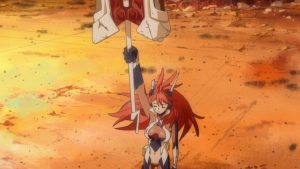 Self Sacrifice: Right out of the gate we have Miku talking about how Hibiki dies on the battlefield with blood spilling out of her mouth. I think the implication is that Hibiki will sacrifice herself singing her Superb Song much the same way Kanade did in this episode. So, I think our first real theme in Symphogear is the willingness to sacrifice one’s self for others. If anything, Kanade sacrificed herself to save just one person. It seems she could have withdrawn if Hibiki hadn’t fallen near her. She definitely knew she was at her limit, but she stayed and died for Hibiki’s sake.
Self Sacrifice: Right out of the gate we have Miku talking about how Hibiki dies on the battlefield with blood spilling out of her mouth. I think the implication is that Hibiki will sacrifice herself singing her Superb Song much the same way Kanade did in this episode. So, I think our first real theme in Symphogear is the willingness to sacrifice one’s self for others. If anything, Kanade sacrificed herself to save just one person. It seems she could have withdrawn if Hibiki hadn’t fallen near her. She definitely knew she was at her limit, but she stayed and died for Hibiki’s sake.
Being Flexible: Kanade and Tsubasa’s early conversation before the concert gives us at least a couple more themes. We have Tsubasa being shy / frightened / worried because, in Kanade’s words, she was taking the concert (and the simultaneous experiment?) too seriously. But maybe more profound was Kanade’s statement about oaks falling in the wind while more flexible reeds will live on. Given the harder edge we saw demonstrated by Tsubasa in the present day, could she have become even more inflexible after Kanade’s death? Finally, I think Kanade’s idea that the audience won’t have fun if the performers aren’t might come back, too. Really, I think everything is pointing to Tsubasa having to learn or relearn these lessons after Kanade’s death.
Don’t Give Up Living: Another bit of wisdom from Kanade is the phrase that has saved Hibiki twice now. “Don’t give up living” seems like something that might come back up again. Certainly, Hibiki remembered it as she was on the run from the Noise, but I can see her giving that advice to someone else in the future, as well.
 Helping People: It’s mentioned a couple of times that Hibiki just likes helping people. I think that’s going to be her early motivation. Not to be a hero or fight evil, necessarily, but to help those in need. Presumably, she’ll be much more able to help people, even against Noise attacks, once she completes her transformation.
Helping People: It’s mentioned a couple of times that Hibiki just likes helping people. I think that’s going to be her early motivation. Not to be a hero or fight evil, necessarily, but to help those in need. Presumably, she’ll be much more able to help people, even against Noise attacks, once she completes her transformation.
Special Attacks In This Episode:
I love the title cards that pop up as various characters pull off their powerful special attacks. We’ll see repeat attacks, for sure, but there’s always the chance that we’ll come across a new one.
Things You Should Pay Attention To:
Hopefully the subtitles you are using noted what it said on the back page of the newspaper Miku’s father was reading early in the episode. If not, it said something like: “Rescued Japanese Girl Goes Missing – Survivor of Guerrilla War in South America” Yes. This will be important later.
That Nehushtan armor appears to have woken up or activated but we didn’t find out what happened to it or if it was the cause of the Noise attack. They seemed to be using song energy, “phonic gain”, from the concert to power it or awaken it… so, maybe the same process attracted the Noise?
When Kanade’s armor shatters, its shrapnel strikes Hibiki. We see Hibiki’s large scar mid-episode. And at the end her transformation starts with her chest glowing with power. I think it’s pretty clear Hibiki has inherited Kanade’s powers.
Moment By Moment Notes:
0:03 – Wow, what a way to open a series. Loud, sad rain. And quite a bit of destruction even in the very first background!
1:02 – Here’s our first image of main character Hibiki Tachibana. Note that the picture has had the left portion torn away.
1:41 – That’s one cool looking venue. I guess it’s a stadium but powered by its own giant solar panel?
1:58 – So, the girl we first met in the rain is Miku.
2:05 – Depending on your subtitles, you may miss the key moment. The back of the newspaper reads something like: “Rescued Japanese Girl Goes Missing – Survivor of Guerrilla War in South America”
2:22 – Here is our very first look at Tsubasa Kazanari. She look rather sad / worried!
2:33 – And here’s Kanade Amou. I love how they manage to convey her more outwardly excitement with just the way she sits even before we see her face.
2:56 – And here is Genjuro Kazanari, he seems to be the group leader.
3:17 – Ha, what a fun way to introduce a character, by having her announce her name as she answers a phone call. Yes, this is Ryoko Sakurai, clearly some kind of scientist.
3:43 – This cool looking stadium and giant circular stage was the moment I first perked up and started really paying attention to Symphogear.
4:04 – Kanade’s philosophy here is important.
4:53 – Our first concert sequence of Symphogear, and in a lot of ways its most important by far! Song here is Gyakkou no Flugel (Backlit Wings).
5:18 – This hand drawn animation synced to the computer animated background is really cool.
6:03 – Something about the progression of those lines and the swell of the music make this an oddly powerful moment!
7:30 – Things going wrong in the foreground. In the background is the song Orbital Beat.
7:48 – Our very first look at the Noise.
8:02 – Symphogear isn’t an overly violent show, but here at the beginning it certainly sets the stakes and shows it isn’t playing around with the horror of the Noise.
8:38 – Our first transformation of the series. Also kicks off Kanade’s song Kimi to Iu Oto Kanade Tsukiru Made (The Sound Called You Plays Until It Burns Out)
9:30 – Stardust Foton. Our first named attack via freeze frame title card. These are common throughout Symphogear and pretty awesome, all around!
9:42 – Something has gone wrong with that… armor. Did it call the Noise to the concert?
9:57 – Last Meteor. I love the implications there. An attack named after the thing that killed off the dinosaurs?!
10:04 – I love this bit of animation of Kanade and Tsubasa running forward taking out Noise as they go!
10:26 – Kanade’s words here, and her inability to go further, are important.
11:15 – Note that a portion of Kanade’s Symphogear armor broke off and the shrapnel hit Hibiki.
11:36 – “Don’t give up living” – another phrase that is important.
12:09 – Look how many came to listen today. Is she talking about the people who came to her concert, the Noise who are arrayed out before her, or both? Whatever the case, that line gives me chills.
12:22 – That tear.
12:27 – Our first Superb Song. Also chilling.
13:05 – That blood!
13:34 – That brief moment where you see her body burn away and her head come detached…
13:59 – Lydian Private Music Academy serves as a backdrop for the series.
14:14 – Hibiki’s lifelong hobby is helping others. Including this cat that got stuck in a tree.
14:54 – Tsubasa survived that concert as well. Important to note that just two years ago Hibiki didn’t know who Zwei Wing was. Now, she’s a huge Tsubasa fan!
16:25 – This song is Zettō Ame no Habakiri (Ame no Habakiri, the Ultimate Blade) and serves as Tsubasa’s character song throughout the season and occasionally beyond.
16:58 – Wright Slayer
17:02 – One Thousand Tears. (These seem pretty similar to Kanade’s Stardust Foton. I think this is an inherited / copycat attack that Tsubasa developed as a sorrowful tribute to her lost partner!
17:14 – Blue Flash. Love the traditional Japanese art background on this one!
18:21 – Thanks, Miku… But yes, Hibiki is kinda a weirdo.
18:46 – Yep, total weirdo. But I love her little chant as she runs!
20:16 – Don’t give up living!
20:32 – A gentle yet powerful song…
21:20 – If you listen closely, you can hear “Gungnir” as part of Hibiki’s transformation chant. Go back and listen to Kanade’s and Tsubasa’s and their respective Symphogears (Gungnir and Ame no Habakiri) are part of their chants as well.
22:09 Whoa! That does not look pleasant! Notice how her actual armor forms and deforms around her arms and legs and head after each burst of techno-machinery emerges and goes back into her.
Deal with the Devil - Kakegurui
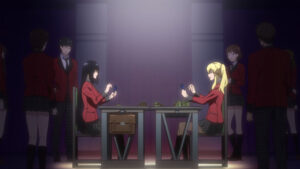 Kakegurui is set at a fictional high school for the children of the ultra wealthy elite who control business and government. The school has normal classes, but what sets it apart from normal institutions of learning is the way every after school activity involves massively high stakes gambling. From poker to roulette to far stranger and more dangerous games of chance, Hyakkaou Private Academy’s real goal is to ready these up and coming future titans of politics and industry for the tense, high stakes situations they’ll face in the real world.
Kakegurui is set at a fictional high school for the children of the ultra wealthy elite who control business and government. The school has normal classes, but what sets it apart from normal institutions of learning is the way every after school activity involves massively high stakes gambling. From poker to roulette to far stranger and more dangerous games of chance, Hyakkaou Private Academy’s real goal is to ready these up and coming future titans of politics and industry for the tense, high stakes situations they’ll face in the real world.
Coming in to this frankly bizarre setting is transfer student Yumeko Jabami. If this were any other show, Yumeko would beat back the all powerful student council who controls every aspect of school life. She’d be an unimpeachable white knight outplaying everyone in this den of vipers. Instead, though she is friendly and has good morals, Yumeko is, in some ways, the most ruthless and gambling crazed of all the academy’s students!
Yumeko doesn’t so much as bat an eye when her fellow students look down on her or others. She doesn’t care if the student council has made having gambling debt at this school akin to being a slave to your fellow students. She doesn’t give a second thought to people trying to literally take control of others’ entire lives. All she wants is the most exciting, tension-filled gambles possible. The higher the stakes the better. The few times we ever see Yumeko angry is when someone tries to intentionally lose. She doesn’t care if you cheat as long as the base rules of the game are fair as she’ll always find a way to outplay you. But rig a game so that she is sure to win? So that she doesn’t get the thrill of being on the knife’s edge of victory and defeat? That’s her biggest turn-off and she might never speak to you again!
“Deal With The Devil” the opening song for Kakegurui’s first season, is a blast. This fast paced, upbeat, jazzy number is filled to the brim with edgy, double entendre lyrics all relating to gambling. Raising the stakes. Seeing through an opponent’s strategy. Having an unbeatable hand. Etc. It’s gotta be Yumeko singing here, and she is in full control of the situation! The song is the perfect opening for a show that is, itself, wild and edgy. “Deal With The Devil” rarely if ever comes into play during the show. It seems satisfied to open each episode along side its deviously suggestive bits of animation then wait for its chance to impress all over again next episode. Speaking of that animation, it is filled with spoilers for both the first and second season. The best kind. The kind that only make sense once you watch the show. Until then, the frantic pacing of the music will more than keep you occupied.
For a long time, I thought “Deal With The Devil” was a song whose speed and lyrics stuffed with double meanings would be all but impossible to fit into English. There doesn’t seem to be enough time to convey everything as the music zooms to the next line and next verse in the blink of an eye. Boy was I wrong! Kayli ‘Kiyo’ Mills did an outstanding job of creating a completely original cover for the song that lives up to its fast paced power. My one complaint, which seems a bit embarrassing when I say it out loud, is that she fails to meow at the appropriate time! But you know what? For a show as slyly suggestive as Kakegurui… that kind of thinking is absolutely perfect!

